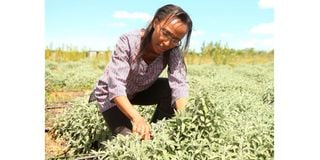Premium
Business graduate and her herbs for export

Grace Muchai tends to her herbs at her farm in Isinya, Kajiado County, where she grows more than 30 different types of herbs, the most common being sage.
The cosmopolitan Isinya township on the outskirts of Kajiado town makes it ideal for farming and agribusiness.
We drive eight kilometres to Kisaju, on the sparsely populated Isinya-Pipeline road, then divert into a sea of shrubs. Some are pale green. The aroma is powerful.
“Mine is the largest sage farm in this region. I now grow more than 30 herbs and spices,” says Grace Muchai, a business graduate and the farm owner.
The three-acre piece also has chamomile ,rosemary, tarragon, oregano, lemon grass, basil, chives, aloe vera, thyme and other herbs.
Ms Muchai started the venture in 2022 when growing herbs was gaining popularity in Kenya.
She had been informed that herbs have nutrients and compounds with significant health benefits.
That prompted her to embark on market research. She concluded that growing rare herbs would be profitable.
To bolster her skills and knowledge, Ms Muchai consulted the Kenya Institute of Organic Farming.
The experts at the institute gave her information on how to set up an organic farm by incorporating agroforestry, vermiculture and other systems.
Ms Muchai also gained more knowledge and skills on herb production from workshops organised by the Kenya Organic Agricultural Network.
Because the young farmer had installed irrigation systems when growing other crops, she only needed Sh100,000 to set up the herbs project.
The money went into the purchase of seedlings and land preparation.
Ms Muchai’s day ordinarily begins with a working plan that involves taking her employees through their duties.
She then monitors and evaluates their work.
“The first step in sage cultivation is land preparation. Manure is incorporated to into the soil to improve structure and moisture content,” the herb grower tells Seeds of Gold.
Seeds are sourced from credible and certified propagators.
After planting, organic fertiliser and foliar spray are applied to help in vegetative growth and root development.
“We water the land before planting. This moistenens the soil in the first few weeks of establishment,” Ms Muchai says, adding that preventive spray is also administered after every two weeks.
The first harvest of sage is three to four months after planting.

Grace Muchai at her farm in Kisaju, Isinya in Kajiado county.
This goes on every month or month and a half for three years, depending on the management practices.
It is cut between 15 to 18 centimetres to the shoot.
Ms Muchai gets about 400 kilogrammes of sage in one season .
Long droughts
After harvesting, the sage is graded, bunched and weighted, depending on a customer’s specifications.
Most of Ms Muchai’s customers prefer raw sage that goes for Sh250 to Sh300 per kilo.
The price usually depends on quality. Most of the buyers are outside Kenya.
“Growing herbs has many challenges. Unskilled workers are not really reliable so I must be around most of the time,” she says.
The other challenges are the long droughts and getting the right technical advice.
She has learnt many lessons, key among them being sage herbs are easy to grow and manage.
“One can start small and scale up production with time,” she says.
And she has a five-year dream. Ms Muchai hopes to diversify from just drying herbs to value addition. She hopes to begin making sage oil and packaging dried herbs.





